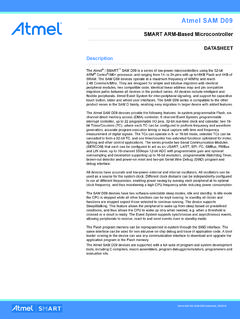Transcription of DC Power-Line Communication Reference Design
1 Ajinder Singh , Dave Hermann TI Designs DC Power-Line Communication Reference Design TI Designs Design Features TI Designs are analog solutions created by TI's analog Robust protection against power -up surges with experts. Reference Designs offer the theory, part two-stage AC-coupling Design with TVS protection selection, simulation, complete PCB schematic and power Design implements low-pass filtering to filter layout, bill of materials, and measured performance of PLC Communication from switching regulator useful circuits. Circuit modifications that help to meet operation alternate Design goals are also discussed.
2 Hardware and software supports multiple nodes Design Resources DC-input voltage 18-V to 35-V operation Long cable support, (40-m) cable passed with no 24 VDCPLCEVM Tool Folder Containing Design Files bit errors even at the lowest Transmitter power AFE031 Product Folder Level TMS320F28035 Product Folder Configurable hardware that supports different PLC. LM34910 Product Folder standards TPS62170 Product Folder Complete PHY, MAC, and application layer TPD1E10B06 Product Folder TMDXEVM3358 Tool Folder Featured Applications Industrial control Lighting applications Smoke and fire detection systems and many more building automation applications ASK Our Analog Experts WebBench Calculator Tools TI Designs Precision Library button DC power DC/DC Bus SPI.
3 GPIO. C2000 AFE031. ADC. Slave button Module(s). PLC Modem (Master button Module). JTAG. UART. Host (Debug). touch - AM335x screen To LCD System DC/DC: LM34910,TPS62170. Network Processor Module An IMPORTANT NOTICE at the end of this TI Reference Design addresses authorized use, intellectual property matters and other important disclaimers and information. All trademarks are the property of their respective owners. TIDU160 October 2013 DC Power-Line Communication Reference Design 1. Submit Documentation Feedback Copyright 2013, Texas Instruments Incorporated System Description 1 System Description The DC (24 V, nominal) Power-Line Communication (PLC) Reference Design is intended as an evaluation module for users to develop end-products for industrial applications leveraging the capability to deliver both power and communications over the same DC- power line.
4 The Reference Design provides a complete Design guide for the hardware and firmware Design of a master (PLC) node, slave (PLC) node in an extremely small (approximately 1-inch diameter) industrial form factor. The Design files include schematics, BOMs, layer plots, Altium files, Gerber Files, a complete software package with the application layer, and an easy-to-use Graphical User Interface (GUI). The application layer handles the addressing of the slave (PLC) nodes as well as the Communication from the host processor (PC or Sitara ARM MPU from Texas Instruments, see Figure 1).
5 The host processor communicates only to the master (PLC) node through a USB-UART interface. The master node then communicates to the slave nodes through PLC. The easy-to-use GUI (see Figure 7) is also included in the EVM that runs on the host processor and provides address management as well as slave-node status monitoring and control by the user. The Reference Design has been optimized from each slave (PLC)-node source-impedance perspective such that multiple slaves can be connected to the master (see Section ). Protection circuitry has also been added to the analog front-end (AFE) so that it can be reliably AC coupled to the 24-V line (see Section ).
6 Also note that this Reference Design layout has been optimized to meet the PLC- power requirements. See Section for the AFE031 layout requirements for high-current traces. At the heart of this Reference Design are the AFE from TI, AFE031 (see Figure 2), to interface with power lines and the TMS320F28035 Piccolo Microcontroller (see Figure 3) that runs the PLC-Lite protocol from TI (see Section 5). AFE031. The AFE031 device is a low-cost, integrated, Power-Line Communication (PLC) AFE device that is capable of capacitive-coupled or transformer-coupled connections to the power line while under the control of a DSP or microcontroller.
7 The AFE031 device is also ideal for driving low-impedance lines that require up to A into reactive loads. The integrated receiver is able to detect signals down to 20 VRMS and is capable of a wide range of gain options to adapt to varying input signal conditions. This monolithic integrated circuit provides high reliability in demanding Power-Line communications applications. The AFE031 transmit power -amplifier operates from a single supply in the range of 7 V to 24 V. At a maximum output current, a wide output swing provides a 12-VPP (IOUT = A) capability with a nominal 15-V.
8 Supply. The analog and digital signal-processing circuitry operates from a single power supply. The AFE031. device is internally protected against overtemperature and short-circuit conditions. The AFE031 device also provides an adjustable current limit. An interrupt output is provided that indicates both current limit and thermal limit. There is also a shutdown pin that can be used to quickly put the device into its lowest power state. Through the four-wire serial-peripheral interface, or SPI , each functional block can be enabled or disabled to optimize power dissipation.
9 The AFE031 device is housed in a thermally-enhanced, surface-mount PowerPAD package (QFN-48). Operation is specified over the extended industrial junction temperature range of 40 C to +125 C. C2000. The F2803x Piccolo family of microcontrollers (C2000 ) provides the power of the C28x core and control- law accelerator (CLA) coupled with highly integrated control peripherals in low pin-count devices. This family is code-compatible with previous C28x-based code, as well as providing a high level of analog integration. An internal voltage regulator allows for single-rail operation.
10 Enhancements have been made to the HRPWM module to allow for dual-edge control (frequency modulation). Analog comparators with internal 10-bit references have been added and can be routed directly to control the PWM outputs. The ADC converts from 0 to fixed full scale range and supports ratiometric VREFHI and VREFLO. references. The ADC interface has been optimized for low overhead and latency. Based on TI's powerful C2000-microcontroller architecture and the AFE031 device, developers can select the correct blend of processing capacity and peripherals to either add Power-Line Communication to an existing Design or implement a complete application with PLC communications.











